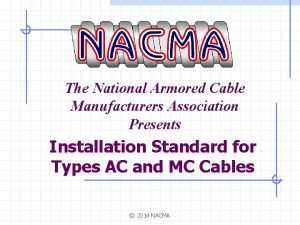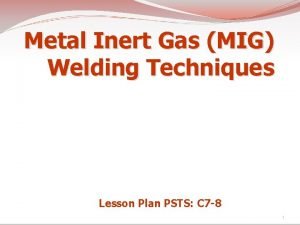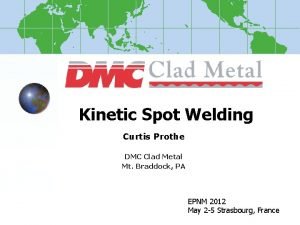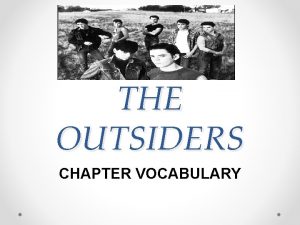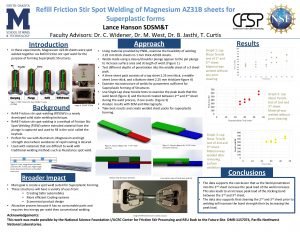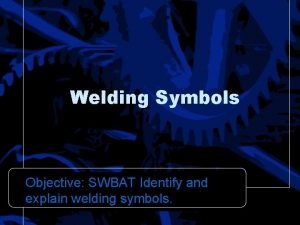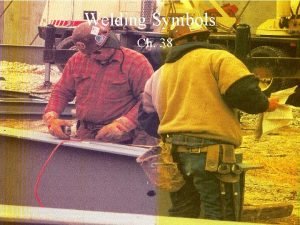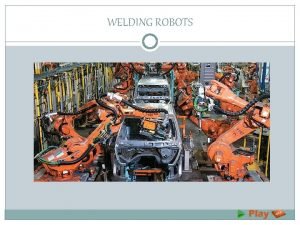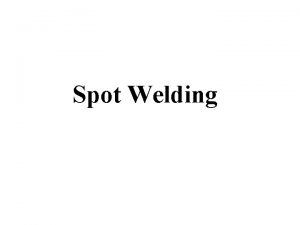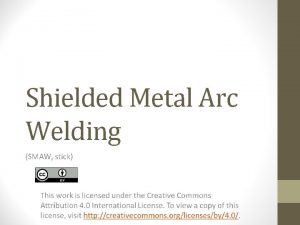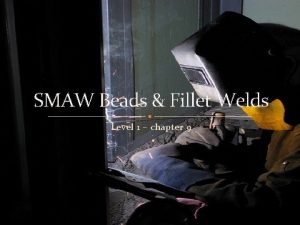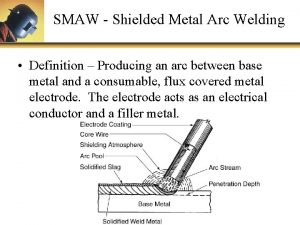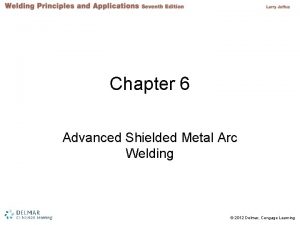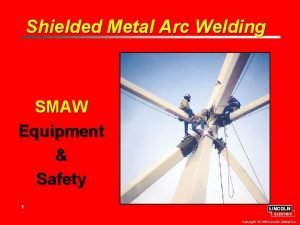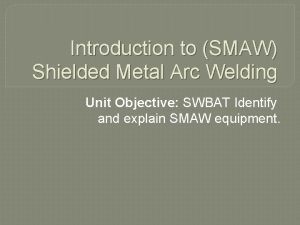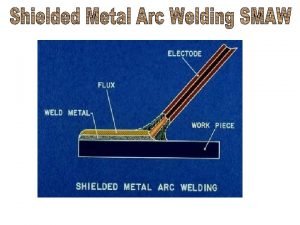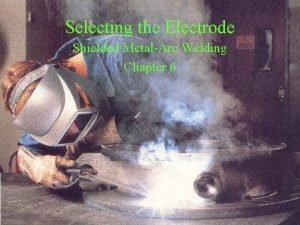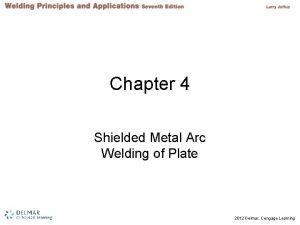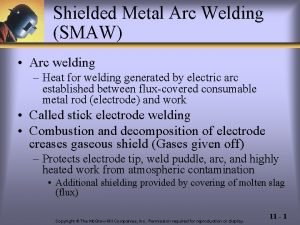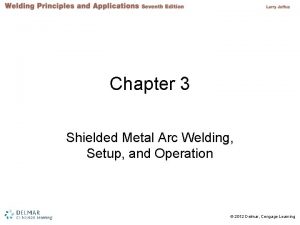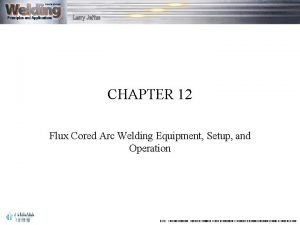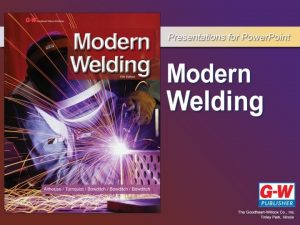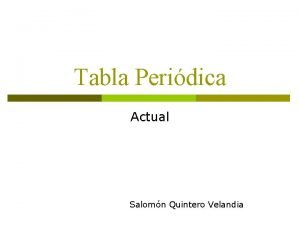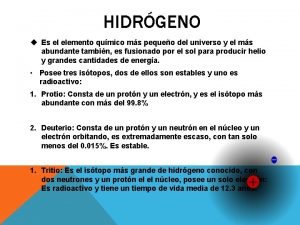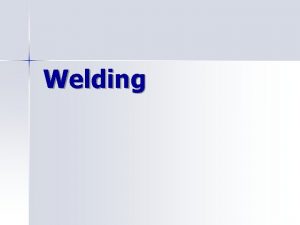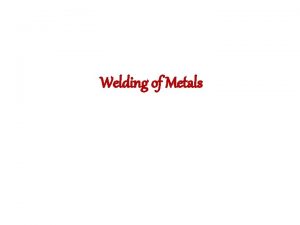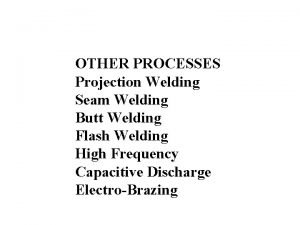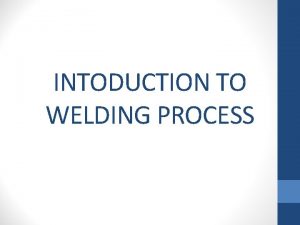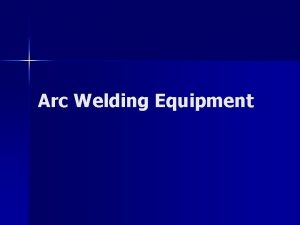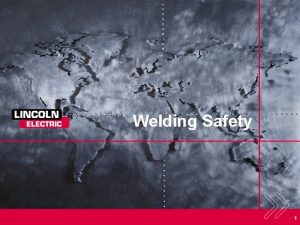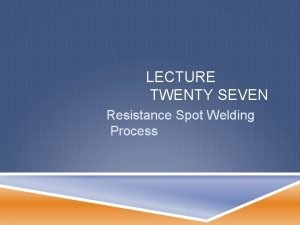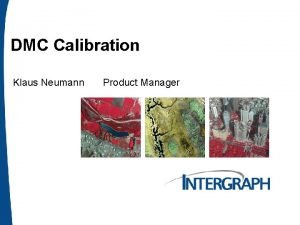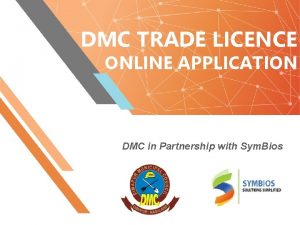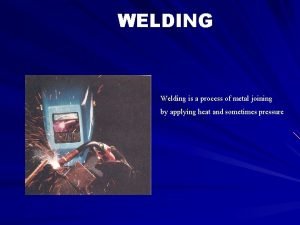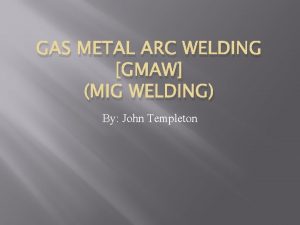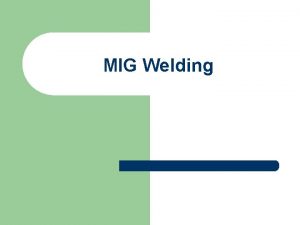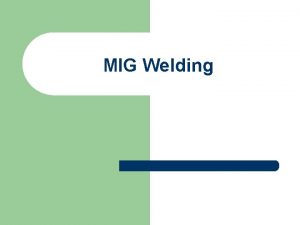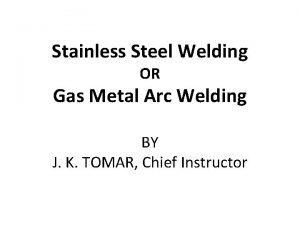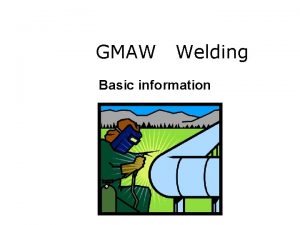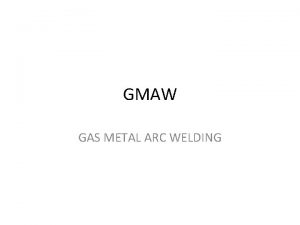Kinetic Spot Welding Curtis Prothe DMC Clad Metal





























- Slides: 29

Kinetic Spot Welding Curtis Prothe DMC Clad Metal Mt. Braddock, PA EPNM 2012 May 2 -5 Strasbourg, France

Dynamic Materials Corporation Kinetic Spot Welding (KSW) was developed and patented by DMC to: Ø Provide a spot weld having the qualities of an Explosion Weld. Ø Create a system viable for use in any manufacturing or fabricating environment. Ø Provide a means of repetitive, reliable spot welding of thin dissimiliar metals.

Dynamic Materials Corporation KSW: A new generation of welding from and old family tree. Ø Kinetic spot welding is a subset of the well developed, robust Explosion Welding Technology Ø A flyer sheet is accelerated across a distance to collide with a fixed base sheet under conditions which cause welding Ø For kinetic spot welds, the explosive energy source is replaced with a highly focused, common industrial alternative

Dynamic Materials Corporation Explosion Welding (EXW) Synopsis Ø EXW is a well known technology for joining dissimilar metals. Ø EXW is a Cold Process - No bulk heating of the metals, no diffusion, continuous melting, or HAZ Ø Large explosive energy requirements limit the use to remote, or isolated areas.

Dynamic Materials Corporation EXW Spot Welds Ø Explosion spot welding demonstrated with reduced explosive quantities Ø EXW Spot welds technically successful, but still plagued by explosive licensing and regulatory issues.

Dynamic Materials Corporation Kinetic Spot Welding (KSW) Ø Utilizes the energy of a high velocity projectile to generate the collision parameters necessary to create a weld. Ø KSW projectile can be accelerated by a deflagrating product (propellant, or gunpowder), pneumatic or hydraulic pressure, gas combustion or magnetic impulse. Ø Eliminates the use of explosives

Dynamic Materials Corporation Kinetic Welding Schematic # 1

Dynamic Materials Corporation Kinetic Welding Schematic # 2

Dynamic Materials Corporation Kinetic Welding Schematic # 3

Dynamic Materials Corporation Kinetic Welding Schematic # 4

Dynamic Materials Corporation KSW Development Ø In order to develop a kinetic spot weld, the parameters necessary to develop EXW must be created. Ø The primary parameters to be controlled are: ØEnergy ØCollision Angle ØCollision Velocity

Dynamic Materials Corporation KSW Development Ø The projectile must convey the proper amount of kinetic energy, requiring a balance of velocity and mass. Ø The projectile material must not damage the cladding metal during impact.

Dynamic Materials Corporation KSW Development Ø Welding parameters were achieved by developing the proper: ØProjectile Shape ØProjectile Material type ØImpact velocities

Dynamic Materials Corporation KSW Parameters Cladder Metal Cladder Thickness Base Metal Projectile Velocity (ft/sec) Projectile Velocity (m/sec) Copper 102 1. 6 mm (0. 063”) Carbon Steel 2000 610 Tantalum 0. 25 mm (0. 010”) Carbon Steel 1750 530 Tantalum 0. 50 mm (0. 020”) Carbon Steel 2150 650 Aluminum 5052 O 1. 6 mm (. 063”) Aluminum 5052 O 2150 650

Dynamic Materials Corporation Materials Welded Using KSW Ø 1. 6 mm Copper welded to Carbon Steel

Dynamic Materials Corporation Materials Welded Using KSW Ø Copper to Carbon Steel interface shown at 50 x

Dynamic Materials Corporation Materials Welded Using KSW Ø Aluminum 5052 O to Aluminum 5052 O KSW Interface

Dynamic Materials Corporation KSW Development Ø During EXW, standoff is achieved by using sacrificial devices in the interface Ø In KSW, the cladding metal is dimpled to create standoff distance without introducing foreign material in the interface

Dynamic Materials Corporation Multiple KSW Sample 0. 5 mm Tantalum bonded to Carbon Steel

Dynamic Materials Corporation Materials Welded Using KSW Ø 0. 50 mm Tantalum welded to Carbon Steel 14 mm 38 mm

Dynamic Materials Corporation KSW Testing Ø Ultrasonic inspection show that projectiles 18. 5 mm in diameter create weld diameters from 10 to 14 mm. Ø Typical destructive testing techniques, such as ASME SA 265 shear strength testing are not viable for such thin metals. Ø DMC Developed a hydrostatic testing fixture to test the strength of the KSW weld.

Dynamic Materials Corporation KSW Testing Ø KSW sample of 0. 50 mm Tantalum. Carbon Steel hydrostatically tested. Ø >55 MPa was applied without weld failure or joint separation. Ø Bond strength of spot weld exceeded the shear strength of the tantalum.

Dynamic Materials Corporation Hydro-Static Test Sample Tantalum Sheared under pressure - KSW intact

Dynamic Materials Corporation Advantages of KSW Spot Welding ØProvide a spot weld having the qualities of an Explosion Weld. ØCan be used in a typical fabrication shop environment ØDoes not require the use of explosives

Dynamic Materials Corporation Advantages of KSW Spot Welding ØBest suited for very thin cladding sheets ØCan be used to attach a liner inside a finished vessel ØCan be used for repair of damaged cladding

Dynamic Materials Corporation Limitations of KSW Ø Not a full area cladding technology. Each spot weld is limited to a size of approximately 10 to 16 mm Ø Not suitable for thick cladding

Dynamic Materials Corporation Potential KSW Applications Ø Lining vessels with thin layers of expensive metals such as Tantalum or Niobium. Ø Spot welding of alloys and dissimilar metals that are difficult or impossible to weld with conventional resistance spot welding techniques Ø Attachment of applique spots, such as thin platinum discs onto titanium

Dynamic Materials Corporation Summary - Kinetic Spot Welding Ø Provides Spot Welds with EXW qualities Ø Possible to produce spot welds between practically any metal combination Ø Viable in any manufacturing environment Ø Rapid cycle time possible with automation

Dynamic Materials Corporation Thank You For More Information on DMC Visit www. dynamicmaterials. com
 Cable manufacturers association
Cable manufacturers association Mig welding process
Mig welding process Dmc cladding
Dmc cladding The great gatsby vocabulary
The great gatsby vocabulary The outsiders chapter 1 vocabulary
The outsiders chapter 1 vocabulary Richard davidson md
Richard davidson md Refill friction stir spot welding
Refill friction stir spot welding Backing weld symbol
Backing weld symbol Fillet symbol drawing
Fillet symbol drawing Robotic welding introduction
Robotic welding introduction Spot welding definition
Spot welding definition Chapter 3 review joint design and welding terms
Chapter 3 review joint design and welding terms Shielded metal arc welding definition
Shielded metal arc welding definition Stringer or weave bead
Stringer or weave bead Smaw welding meaning
Smaw welding meaning Chapter 6 shielded metal arc welding
Chapter 6 shielded metal arc welding Smaw safety
Smaw safety Smaw unit
Smaw unit Welding smaw
Welding smaw Fill freeze electrode
Fill freeze electrode Establishing a shielded metal arc is often described as
Establishing a shielded metal arc is often described as Weave pattern welding definition
Weave pattern welding definition How is the smaw welding heat produced
How is the smaw welding heat produced Chapter 3 shielded metal arc welding
Chapter 3 shielded metal arc welding Rutile based flux definition
Rutile based flux definition Bullet shaped ripples welding definition
Bullet shaped ripples welding definition Periodo en quimica
Periodo en quimica Hidrgeno
Hidrgeno Periodic trends acidity
Periodic trends acidity Metals used
Metals used
